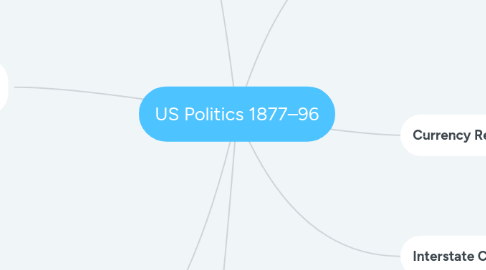
1. Civil Service Reform
1.1. Jackson believed that the “spoils system”—the awarding of government positions to loyal political supporters—actually enhanced the democratic process
1.2. President Hayes's advocacy of civil service reform put him on a collision course with Congressional bosses. He removed Chester Arthur and Alonzo Cornell from the New York City Customs House for failure to carry out reforms. Both were underlings of New York Senator and Republican political boss Roscoe Conkling, who thought it an attack on him or his machine
1.3. When President James A. Garfield was assassinated four months after assuming office, it was discovered that the assassin was an office seeker who had been trying to get a position in Garfield’s administration. Garfield had shown great promise before his assassination, and support for civil service reform grew significantly.
1.3.1. led to the founding of the National Civil Service Reform League in 1881.
1.4. Pendleton Civil Service Reform Act in 1883- The act in effect ended the spoils system by classifying certain jobs, which meant they could not be awarded on the basis of patronage. The United States Civil Service Commission was established to construct a system under which people would be hired on merit rather than on the basis of political connections
2. Regulating Commence and Business
2.1. the federal government had the exclusive right to control commercial transactions between the states.
2.2. was now the governments responsibility to oversee these things.
2.3. During the last half of the 19th century it became apparent that large businesses needed to be regulated.
2.3.1. Business-labour relations often developed into bloody contests fought to the death between business managers and the employees.
3. Social Dawinism
3.1. An ideology that argues that poor people deserve to be poor b/c they are naturally inferior
3.2. This meant that businesses were expected to do whatever was necessary to survive. Only by defeating their competitors could they hope to succeed. Business practice became ruthless and cutthroat; survival went not only to the fittest, but also to the wiliest, the most crooked, and the most corrupt organizations.
3.3. People who depended on railways for business purposes were hurt by the fact that railroads had a monopoly on the transportation of goods from producer to market.
3.4. Shipping rates were uneven and often unfair
3.5. large corporations such as Carnegie Steel or Standard Oil were able to pressure rail companies to give them favorable rates and rebates
3.6. Farmers were heavily affected by this b/c they had no choice but to use these overpriced railroads to sell their goods.
4. Agricultural Discontent & The Populist Movement
4.1. The Populist movement began in the late 19th century
4.1.1. Started due to farmers who were isolated in the Great Planes
4.1.1.1. They had many problems: high tariffs, railroad rates, tight currency, unfavourable marketing arrangements
4.2. Their discontent led to the creation of the Granger movement, the “Patrons of Husbandry,” a secret organization designed to promote the interests of farmers.
4.3. The Grangers group were aided by others who faced many of the same problems, such as small businessmen and merchants. They began to sponsor legislation and got laws passed at the local and state level in the 1870s and 80s.
4.3.1. Many conservative interests saw the Populists as a threat to the basic economic system of the United States, but the free market economy had always worked against the farmer.
4.3.2. The Populists were not outright Socialists, but many of their goals resembled those of the European socialist parties which were flourishing at the same time. The Populists’ goals included more equitable distribution of wealth, and a humanistic social system.
5. Tariffs
5.1. there are two kinds of tariffs
5.1.1. Ordinary revenue tariffs are modest taxes placed on imports to fund agencies responsible for goods and people entering the United States. Customs and immigration services were financed heavily by revenue tariffs.
5.1.2. Protective tariffs were created to support American businesses and industries.
5.1.2.1. High tariffs allow American businesses to successfully compete with foreign businesses, b/c they raise the price of imported goods which made American products more attractive to consumers.
5.1.2.1.1. Although high tariffs were not beneficial to consumers, industrial workers were told that if American businesses lost out to foreign competition, workers jobs would be threatened.
5.1.2.2. Underworld Tariff Act of 1913- lowered tariffs significantly for the first time since 1857.
6. Currency Reform
6.1. The amount of money in circulation determines its worth: the more money in circulation the lower its value.
6.2. Main issue regarding money supply was weather it was hard or soft
6.2.1. Hard money was not subject to inflation making it stable
6.2.1.1. Appealed to bankers and operators of other financial institutions
